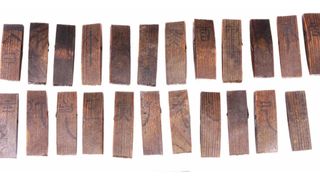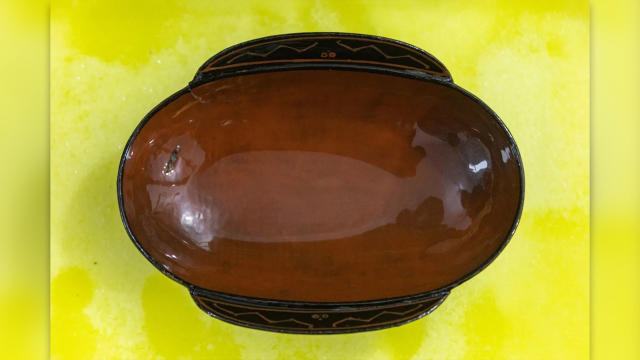2,000-year-old ‘celestial calendar’ discovered in ancient Chinese tomb
Each of the wooden slips is marked with Chinese characters that relate to the traditional Tiangan Dizhi astronomical calendar. Perforations on their edges suggest they were once tied together. (Image credit: Chongqing Cultural Relics and Archaeology Research Institute)
Archaeologists in China have unearthed a mysterious set of rectangular wooden pieces linked to an ancient astronomical calendar. The artifacts were discovered inside an exceptionally well-preserved 2,000-year-old tomb in the southwest of the country.
Each of the 23 wooden slips is about an inch (2.5 centimeters) wide and 4 inches (10 cm) long and displays a Chinese character related to the Tiangan Dizhi, or “Ten Heavenly Stems and 12 Earthly Branches” — a traditional Chinese astronomical calendar established during the Shang dynasty, which ruled from about 1600 B.C. to about 1045 B.C.
Archaeologists think one of the slips may have represented whatever was the current year and that the other 22 slips could have been used to specify any particular year in the ancient calendar, according to a translation of a story on the China News website, an agency run by the Chinese government.
 The artifacts were found in a well-preserved tomb, dated to about 2,200 years ago, unearthed earlier this year in the Wulong district of China’s Chongqing municipality. (Image credit: Chongqing Cultural Relics and Archaeology Research Institute)
The artifacts were found in a well-preserved tomb, dated to about 2,200 years ago, unearthed earlier this year in the Wulong district of China’s Chongqing municipality. (Image credit: Chongqing Cultural Relics and Archaeology Research Institute)
Circular perforations at the edges of each slip suggest they were once tied together.
However, it’s not yet clear how the set of calendrical wooden slips would have functioned, an expert told Live Science.
This is the first time such objects have been found in an ancient tomb, although the practice of writing characters on strips of wood or bamboo was common in China before the invention of paper.
 Archaeologists and university students started working at the site in the Wulong district in March this year. (Image credit: Chongqing Cultural Relics and Archaeology Research Institute)
Archaeologists and university students started working at the site in the Wulong district in March this year. (Image credit: Chongqing Cultural Relics and Archaeology Research Institute)
The wooden slips and many other artifacts were discovered earlier this year in a tomb in the Wulong district, about 870 miles (1,400 kilometers) southwest of Beijing, archaeologists from the Chongqing municipal government told the Global Times — which is also run by the Chinese government.
The tomb contains a written list of all the burial items, which also states that it was built in 193 B.C. That places the tomb during the time of the Western Han dynasty, which ruled much of China from 206 B.C. to A.D. 9; it was followed by the Eastern Han dynasty, which ruled until A.D. 220, and together they are considered a “golden age” when many Chinese traditions were established.
Related Post
A shocking documentary proves that mermaids do exist
SHOCKING Revelation: Thuya, Mother of Queen Tiye, Was the Grandmother of Akhenaten and Tutankhamun—What Ancient Egyptian Secrets Did She Leave Behind?
Breaking News: Astonishing Discoveries at Karahan Tepe Confirm an Extraterrestrial Civilization is Hiding on Earth, and NO ONE Knows!
Breaking News: Researchers FINALLY Discover U.S. Navy Flight 19 After 75 Years Lost in the Bermuda Triangle!
NASA’s Secret Investigation: Uncovering the Astonishing Mystery of the UFO Crash on the Mountain!
Explosive UFO Docs LEAKED: Startling Proof That Aliens Ruled Ancient Egypt!

